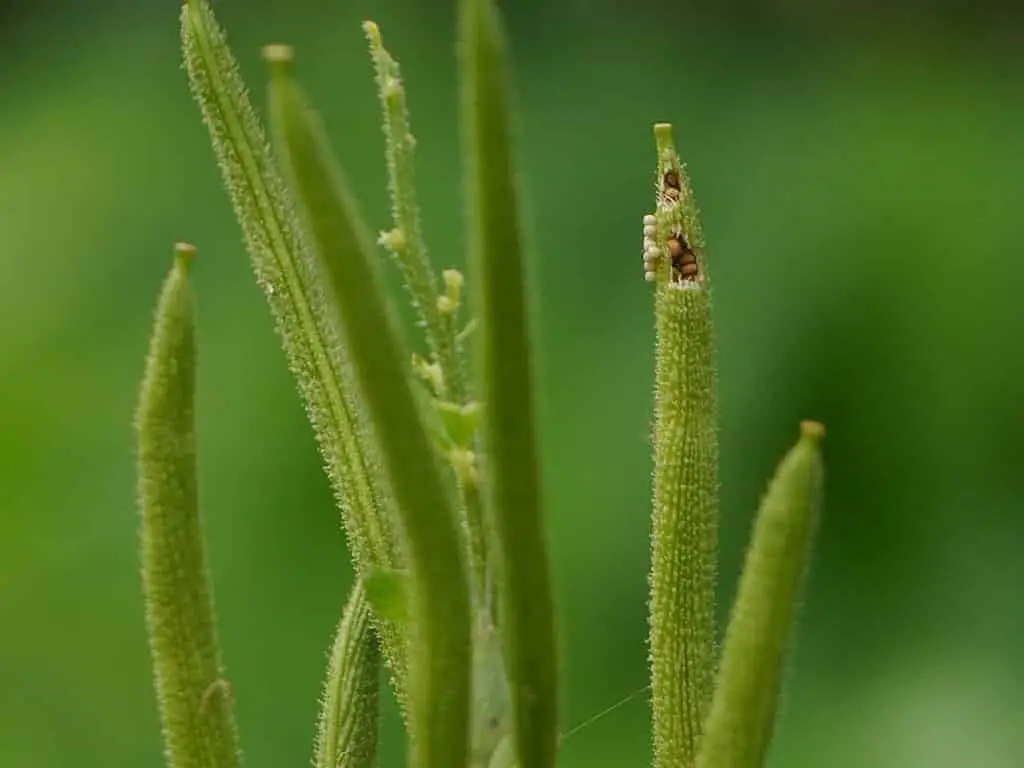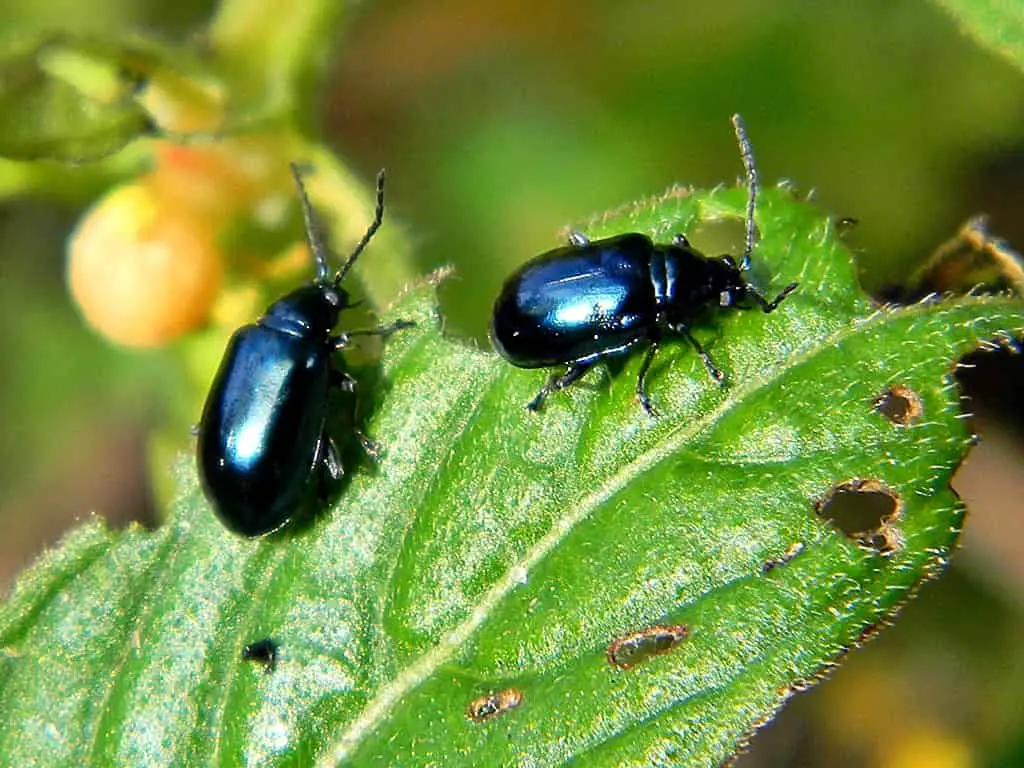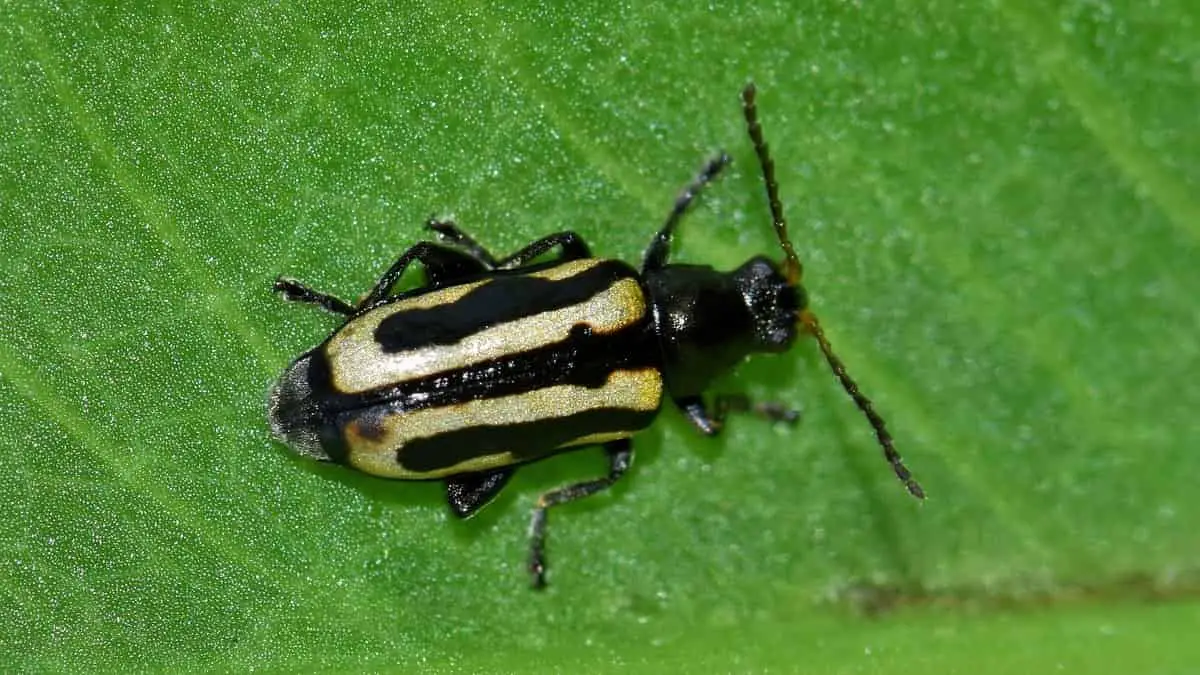What are Flea Beetles
Flea beetles belong to Chrysomelidae, a leaf beetle family. Having large rear legs, these small, shiny insects can jump like fleas. These insects can overwinter in plant debris and soils. They also can inflict both below and above ground damages to the host plants.
This article focuses on flea beetles, their identification, damages, and treatment.
There are several species of flea beetles. Depending on the regions, the colors of these insects vary widely. Most commonly, these insects are found in black, brown, white-striped, orange striped, yellow, metallic, and greenish-black colors.
Some species of these insects infect a wide range of plants. However, most species are restricted to certain families of plants.
For example, the species that feed on Cruciferous (Cole crops) plants like cabbage, kale, and broccoli include:
1.) Crucifer Flea Beetle (Phyllotreta cruciferae)
2.) Striped Flea Beetle (Phyllotreta striolata)
3.) Western Black Flea Beetle (Phyllotreta pusilla)
Similarly, the species that feed on Solanaceous (Nightshade) plants like peppers, tomatoes, eggplants, and potatoes include:
1.) Potato Flea Beetle (Epitrixcucumeris)
2.) Eggplant Glea Beetle (Epitrex fuscula)
Table of Contents
Life Cycle

Photo by Dinesh Valke (Wikimedia Commons) (CC BY-SA 2.0)
Typically, the adults overwinter in the plant debris, soil undergrounds, or shady areas like grassy lines. In the spring, these insects come out of their hiding places.
Interestingly, the adults can find their host plants by seeing them visually and by smelling them using olfactory organs. As the temperature increases, they feed on host plants more actively.
After feeding heavily, they start laying eggs, mostly around the bases of the plants. In about 10 days, these eggs begin to hatch. Measuring about 1/8 -1/4 inches long, small white larvae with tiny rear legs and dark heads emerge out.
For the next 3 – 4 weeks, these larvae feed on the plant roots. Subsequently, they take around 7-10 days to pupate. Then, they continue their activities above the ground as others.
In warmer regions, these insects reproduce several generations every year. This can be a serious problem for vegetable gardens. Hence, prevention and (infected plants) curing become essential.
How Flea Beetles Damage Plants
In fact, both the adult flea beetles and their larvae have chewing mouthparts. Hence, they both can inflict severe damages on the plants.
Below Ground Damages
Typically, the larvae feed on underground portions of the plants. This can kill tender seedlings and small plants.
Typically, the common flea beetle larvae feed on the roots and hairs shooting from the roots. This may cause various health issues in the plants. Moreover, plant-specific species can inflict more damage on the crops.
For instance, the tuber flea beetle larvae, western potato flea beetle larvae, etc., can feed on both potato tubers and their roots.
Usually, these types of larvae make shallow grooves on potato surfaces. Later, these grooves develop into scars. In addition, these larvae burrow into the potatoes creating small holes. Staining the potatoes, these holes are usually filled with frass (solid excrement).
These holes also serve as entry points to various microorganisms. These microorganisms, systematically reduce the storage potential of potatoes or cause them to rot.
As a result, the commercial value of the crop reduces significantly.
Above Ground Damages

Photo by Bob Peterson (Wikimedia Commons) (CC BY-SA 2.0)
By chewing the above-ground portions (like flowers, foliage, and stems), the adult flea beetles cause severe damage to the plants.
When the adults chew thick leaves (like broccoli), the damage is referred to as pitting. Similarly, when the same chew thinner leaves (like mustard), the damage is referred to as shot-holing.
The severe above-ground damages can kill tender seedlings and young plants. In established plants, these damages can lead to stress, stunted growth, etc. In rare cases, it may kill the established plants also.
How to Treat Flea Beetles
As the flea beetles jump, you can capture them with sticky traps. You can also use plain talcum powder to repel these insects on peppers, potatoes, tomatoes, and other plants.
During the early season, you can use pesticides to treat these insects on the young plants. However, it is unnecessary in most established plants.
1.) Biological Control Methods
You can introduce beneficial insects like ladybugs, spiders, lacewings, etc., to prey on these insects.
Fungal Pathogens
Typically, the spores of Beauvaria bassiana, a fungal pathogen can effectively kill flea beetle larvae. After germinating on the insect’s surface, these spores infiltrate into the larvae. Then, they liquify their interiors for food and kill them.
During the daytime, the direct sunlight falling on the plants can kill the fungal spores themselves. So, we recommend you applying fungal spray in the evening.
Nematodes
Small soil-dwelling worms called nematodes can also kill the larvae of these insects.
One application lasts for multiple years, killing larvae. However, this method is effective for subsequent generations and may not be an instant cure.
2) Organic Controls Control Methods
You can use Diatomaceous earth, Neem oil (registered for food crops), Insecticidal soaps, Spinosad, Sabadilla, Pyrethrins Etc., to combat these insects.
3) Inorganic (Chemical) Control Methods
If every option fails, you can use chemical pesticides as a last resort. Some of the chemicals that can effectively eradicate these insects include Lambda cyhalothrin, Carbaryl, Permethrin, Malathion, and Cyfluthrin.
If your soil has a long history of diseases, you have to be more diligent. Cooperative extensions can help you with relevant information in this regard.
How to Prevent Flea Beetles
Typically, the flea beetles emerge out in the spring to feed on the plants. If possible, cut off their food sources by delaying transplantation or new vegetation.
After transplanting, cover the plants with row covers and seal them immediately. In this way, you can prevent these insects from accessing new plants.
During fall, till the soil surface completely. You can also use power equipment to increase efficiency. This unearths the hiding insects including flea beetles. This will also help to work the soil during the next spring.
Grow companion plants to save your crops from flea beetles. The tall, early luring crops like radish and nasturtium attract these insects. So, plant them before the main crops. As these insects feed on them, spray labeled pesticides to eliminate them completely.
On the other hand, plants like basil and catnip repel these insects away. So, you can interplant these kinds of plants with your main crops.
Weed Biological Control Agents

Also, many species of flea beetles serve as weed biological control agents. These beneficial species feed on weeds and other nuisance plants, eventually killing them.
For instance, leafy spurge (Euphorbia virgata) is an invasive weed in the US. It also has toxic latex. Herbivores use to avoid it. The government tried flea beetles of the genus Aphthona to control this weed. The result was a huge success.
In fact, these kinds of experiments were carried out at different locations using different species of these insects, based on their genus. Most results were positive.
Top Posts
How to Grow Cabbage Plants in Gardens
What is a Mulch and How to Apply It

